Uncalibrated
Results
Brightness and Contrast Ratio
For the brightness, contrast, and color accuracy tests, we depend on the hardware colorimeter and software to help calibrate the displays. As previously stated, we use a Monaco Optix XR (DTP-94) colorimeter and Monaco Optix XR Pro software. The software and hardware help users to get color that is more accurate from their displays. Before we get to the calibrated results, we took a quick look at the range of brightness and contrast at stock settings while changing just the brightness level.
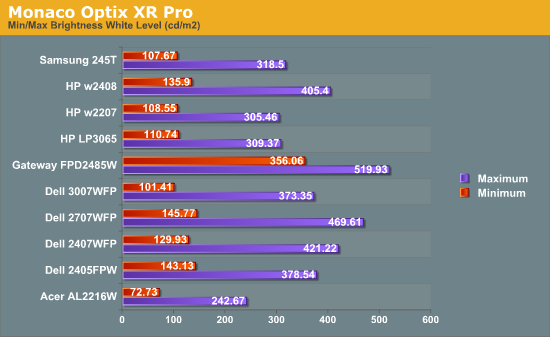
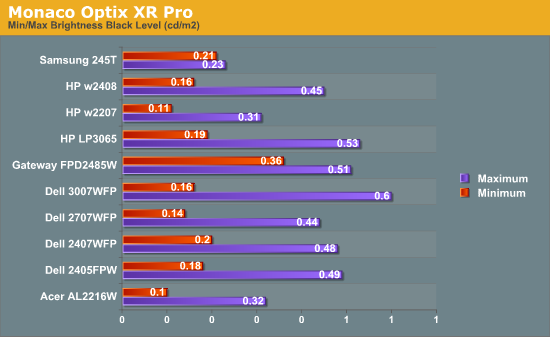
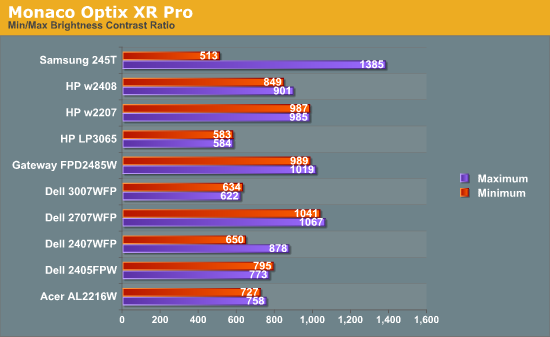
Without adjusting any of the default settings other than brightness, the maximum brightness level of the Samsung 245T reaches almost 320 nits -- as usual, more than most people need. At minimum brightness, we measure just over 100 nits. Further tuning of the color levels allows us to reach slightly lower/higher brightness levels, but the default range is sufficient. At maximum brightness, we measure a contrast ratio of nearly 1400:1 -- even without the dynamic contrast setting enabled. Reducing the brightness also reduces the contrast ratio, and it's interesting to note that black levels are reasonably stable at around 0.22 nits.
What happens when we enable Dynamic CR? Maximum brightness jumps to 350 nits while the black level went up slightly to 0.24 nits, resulting in a final contrast ratio of 1460:1. That's pretty close to the advertised 1500:1 contrast ratio, but the impact on Delta E is quite severe. Even after calibration -- which appears to get confused by Dynamic CR -- we measured an average Delta E of 7.029. That's worse than the uncalibrated Delta E we'll see below, so we recommend turning off the dynamic contrast.
Color Accuracy
The problem with calibrating a display is that it doesn't help all applications. Specifically, the video overlay used when watching DVDs or other movies completely bypasses any color profiles, so you are stuck with the uncalibrated colors. Playing games also uses the default color options. It is possible to tweak things using the OSD, but the amount of color correction that can be done via the OSD pales in comparison to color correction tables. Ideally, we would like to see video drivers begin to apply color profiles to all output -- office applications, movies, games, or anything else.
For uncalibrated color accuracy, we adjust the brightness as well as the contrast and colors (where applicable) using a "calibrate by eye" chart and the OSD controls. Also remember that color accuracy can vary from panel to panel even within the same model, and the results we are reporting are only from testing a single LCD. During testing, Monaco Optix XR Pro sends 24 color patches to the display with the colorimeter measuring the resulting values. The difference between what the requested and actual colors shown on the LCD is Delta E, with lower values being better. Any score less than one is "perfect" -- the naked eye is not going to be able to tell the difference -- and scores less than 2.0 are nearly perfect.
Ideally, you would want all of the tested colors to have a Delta E of less than 1.0, but almost no one is likely to have problems with anything scoring below 2.0. From 2.0 to 4.0, most people still won't notice the slight inaccuracies in the color palette, but when comparing displays side-by-side, differences may be apparent -- multimedia professionals in particular would prefer better colors. Anything above 4.0 begins to represent a more significant deviance, and numerous scores above 6.0 will almost certainly be noticeable by anyone using the display. Consistency is also important, so a display that has very good scores overall but with high spikes on some colors may actually be less desirable than a display with a slightly higher but more consistent average Delta E. Note also that fluctuations of as much as one point in Delta E are possible during a short amount of time. It generally takes 30 minutes for a display to warm up, and we perform all of our calibration and testing after the displays have been running for at least one hour with the screensaver disabled.
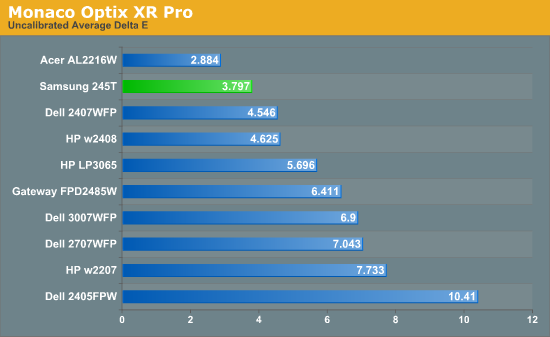
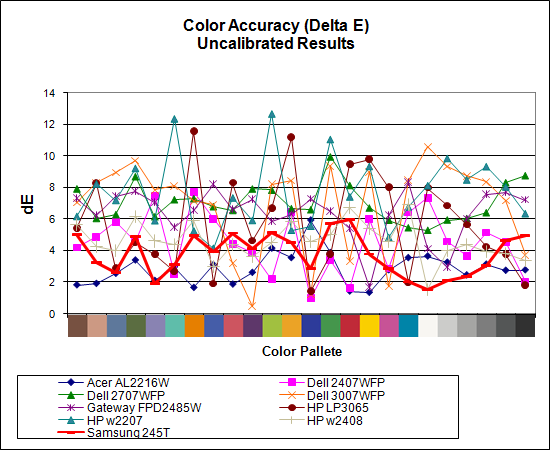
Without any form of color correction, the Samsung 245T rates a very good -- especially relative to the competition -- 3.80, ranking second overall with a relatively large gap between it and the nearest competitors. The Acer still scored better, but with that display had other concerns. The individual color scores are also very good, with the worst still only 6.0 and many others are below 3.0. So far, this is the best overall display when it comes to color accuracy -- provided of course that you stay away from the Dynamic CR setting. It's not perfect, but after seeing so many LCDs with uncalibrated Delta E of over 6.0 this is definitely a noteworthy achievement.










60 Comments
View All Comments
Deusfaux - Thursday, February 7, 2008 - link
I thought Samsung monitors had a 16:9 scaling mode?JarredWalton - Thursday, February 7, 2008 - link
This one doesn't... other Samsung displays might. See the OSD image gallery for details. The only options are "Wide" (fill the whole screen) and "4:3". That means that 5:4 resolutions (1280x1024) will also be distorted no matter what you do. I don't think the minor stretch of 16:9 to 16:10 is terrible, but some people care more about that than I do. Again, though, this is only an issue on non-PC use (or if your drivers don't allow you to correct the scaling).hotdogandchips - Thursday, February 7, 2008 - link
Jarred, can you tell us when the NDA regarding the 2408WFP expires by any chance? ;0JarredWalton - Thursday, February 7, 2008 - link
LOL... actually, no, I can't. Funny thing is that the date isn't set in stone just yet either, which is part of the reason I can't say. It's supposed to be this month, based on what I heard at CES, but it might get moved to early March?AcAuroRa - Thursday, February 7, 2008 - link
According tohttp://www.samsung.com/us/system/consumer/product/...">http://www.samsung.com/us/system/consum.../C070096...
... its a TN.... bah I'm confused -_-.. is it a TN or a PVA?
I actually own a w2408... and I actually like the thing -_-;;...but if there can be some facts straightened out I might go and get a 245T off the 'Egg as it is currently on sale for $650...
JarredWalton - Thursday, February 7, 2008 - link
See above post... the unit I reviewed is most assuredly an S-PVA panel. I believe the PDF is simply erroneous.bobo51 - Thursday, February 7, 2008 - link
I am confused.The article identifies the 245T as having a PVA panel. But I just went to the Samsung website and in their specification PDF for the 245T the panel is stated to be a TN.
Is their website document incorrect?
JarredWalton - Thursday, February 7, 2008 - link
I can absolutely state that the 245T LCD I have is S-PVA (based on how it looks from various angles), and Samsung told me it was S-PVA before I received it. http://www.samsung.com/us/system/consumer/product/...">This states otherwise, so I guess someone just put the wrong information in there. The other possibility is that there are different LCD panels in some of the 245T displays... hopefully not.Most companies do not make a point of stating what sort of technology their panels use. While I can understand that on TN panels, I'd think anyone using a PVA or IPS panel would want to crow about it. Kudos to Samsung for at least putting information on all of their displays in the PDF files; now they just need to make sure the data is correct. :)
I'm going to email my Samsung contact about this and see if there's just an error in the PDF that they can correct.
XrayDoc - Thursday, February 7, 2008 - link
I was all excited about this new display until I read about the limited scaling choices. I can't believe they didn't include a 1:1 or pixel to pixel option! Not everyone has a triple SLI video card setup that can run Crysis well at 1920 x 1200. I'd much prefer to run the game at a lower resolution with black borders and have the "pixels" look sharp, as opposed to stretching the non native resolution to fill the screen and look blurry! Plus automatically stretching 16:9 aspect sources vertically to fill the 16:10 screen is just plain ludicrous. Most people can notice when the aspect ratio is displayed incorrectly. What happens with a 2.35:1 ratio DVD? Does that also get stretched vertically so that you dont' see any black bars at the top or bottom? This single design flaw is a definite deal breaker for me. I hope the upcoming new models from Dell, etc. don't have this same design flaw.yyrkoon - Friday, February 8, 2008 - link
The big question would be; 'why do you need a 24" LCD to play Crysis?' For me personally I cannot see the need for anything much more than a 19" LCD(a good one at that) for gaming. This making current title fly on my C2D system with a 7600GT, and it draws way less power than one of the current higher end cards. Granted I probably wouldnt mind using a 8600 or something that draws slightly more power, and has DirectX 10 capabilities, but I wont go out of my way just yet to purchase another card, especially since I am still using XP Pro.Also I'm noticing complaints about input lag ? I would think this would be an image retouching LCD which doesnt require fast screen refreshes. You can buy cheap fast LCDs that will play games just fine(all day long).